Ijraset Journal For Research in Applied Science and Engineering Technology
- Home / Ijraset
- On This Page
- Abstract
- Introduction
- Conclusion
- References
- Copyright
Job Satisfaction in Banking Sector Employees
Authors: Ms. Mowpia (Asst Professor, Sai Nath University, Ranchi), Dr. Ashok Kumar(Professor, Sai Nath University, Ranchi)
DOI Link: https://doi.org/10.22214/ijraset.2024.64061
Certificate: View Certificate
Abstract
Life and work satisfaction are crucial aspirations for everyone. We dedicate most of our time to employment or engaging in economic activities, which are primary sources of sustaining our livelihoods. Every worker desires a heightened level of contentment from their occupation. Job satisfaction refers to the positivity or negativity with which employees perceive their tasks. It is a psychological concept primarily reliant on employees\' internal emotions. There exist numerous independent variables upon which job satisfaction hinges, including educational credentials, job nature, remuneration, job security, advancement opportunities, and balancing family and work life. This document elucidates the factors impacting job satisfaction within the banking sector. It is widely assumed in organizational behavior research that individuals exhibiting high job satisfaction are likely to be more productive. Moreover, it diminishes grievances, absenteeism, turnover, terminations, and enhances overall work quality, serving as an indicator of longevity.
Introduction
I. INTRODUCTION TO THE BANKING SECTOR
The Indian banking industry presently employs 175,149 workers, with 109,811 branches across India and 171 branches operating internationally. Indian banks have implemented various welfare measures to gratify their staff. Some of these include reimbursing medical expenses, surgeries, providing a cost of living allowance, house rental allowance, professional qualification remuneration, deputation allowances, special area allocations, provident funds, medical assistance, pension schemes, medical check-ups for employees aged 45 and above, in-house medical assistance, residential furniture provisions for officers, entertainment expenses, transfer compensations, leave travel allowances, and festival advances for officers. Each bank adopts distinct approaches to devise schemes that cater to employee satisfaction since job satisfaction is a performance indicator. Enhanced employee performance invariably translates to heightened customer satisfaction, which is paramount for banks to maintain a competitive edge.
II. WHAT CONSTITUTES EMPLOYEE SATISFACTION?
Employee contentment or job satisfaction essentially denotes the degree of contentment or gratification employees derive from their occupations. It is commonly assessed through employee satisfaction surveys. These surveys cover aspects such as remuneration, workload, managerial perceptions, adaptability, teamwork, and available resources. These elements are critical for companies aiming to keep their workforce content and reduce turnover. However, employee satisfaction represents only one facet of the overarching solution. Top of Form
Employee satisfaction and employee engagement are seemingly similar concepts, often used interchangeably by many. Employee satisfaction addresses the fundamental concerns and requirements of employees, serving as a foundational point. However, it typically falls short of addressing deeper significance. Job satisfaction, a term with varied conceptualizations, encompasses all the emotions an individual harbors toward their occupation. Organizational behavior research suggests that individuals who exhibit high job satisfaction tend to be more productive, display greater involvement, and are less inclined to resign compared to those with lower satisfaction levels.
III. LITERATURE REVIEW
Herzberg et al. (1959) introduced the two-factor theory of job satisfaction, proposing that satisfaction and dissatisfaction are distinct, sometimes unrelated phenomena. They identified intrinsic factors, termed "motivators," as job satisfiers, including achievement, recognition, the work itself, and responsibility. Ambrose et al. (2005) conducted a qualitative inquiry into faculty satisfaction and retention, focusing on a private university faculty over a two-year period. Their findings revealed satisfaction or dissatisfaction sources clustering around areas such as salaries, collegiality, mentoring, and departmental heads' reappointment, promotion, and tenure processes. Alam (2013) explored female workers' job satisfaction in various garment factories in Dhaka city, concluding a positive correlation between satisfaction levels and wages. Zeal, Anwar, and Nazrul (2012) examined the comparative job satisfaction of senior male and female executives in Bangladesh, revealing insignificant differences between genders across various job facets.
IV. SIGNIFICANCE OF JOB SATISFACTION
Job satisfaction denotes an individual's contentment with their job, encompassing their overall liking or specific facets such as work nature and supervision. Scholars highlight the variance in job satisfaction measures concerning their emotional depth. Job satisfaction's understanding can be contextualized within relationships with other critical factors, such as general well-being, work-related stress, control, home-work balance, and working conditions. Hoppock's 1985 study focused explicitly on job satisfaction influenced by both job characteristics and relationships with colleagues and supervisors.
A. Objectives
- Evaluate employee satisfaction within the organization.
- Identify factors impacting employee job satisfaction across various sectors.
- Determine measures to enhance job satisfaction.
- Assess employee satisfaction with organizational facilities.
- To provide meaningful recommendations to the organization for enhancing employee satisfaction levels.
Top of Form
V. IMPORTANCE OF THE STUDY
Work holds different significance for individuals; while some find it fulfilling and integral to life, others perceive it as a necessity. Job satisfaction becomes crucial within organizational settings as it allows workers and researchers to assess and improve the factors contributing to job satisfaction. Personal fulfillment encompasses various elements:
- Compensation: Salary, a critical factor, significantly impacts job satisfaction, including the amount and fairness of pay. Oshagbemi (2000) suggests that salary constitutes a major operating cost for organizations, influencing employees' commitment. Herzberg (1964) identified salary as a hygiene factor, where exceeding employee salary expectations leads to increased satisfaction.
- Work Hours: Employee satisfaction can be disrupted when the balance between individual expectations and work demands is unstable, leading to conflict. Discomfort with work and conflicts arise from factors like frequent overtime and inappropriate working hours. Pors (2003) noted that working hours affect life quality, relationships, and consequently, employee satisfaction.
- Working Conditions: The workplace environment significantly influences employee satisfaction, encompassing factors like air quality, temperature, building design, lighting, and noise levels. Some argue that the working environment should address employee and customer needs while striving for organizational excellence.
- Supervision: Management's role is pivotal in employee satisfaction. Providing employees with opportunities to voice their ideas fosters loyalty. Fairness in employee treatment, especially in relations with colleagues and supervisors, significantly impacts satisfaction and behavior, according to Chen (2001). The study aims to explore these elements and their implications for job satisfaction, offering insights for organizational enhancement.
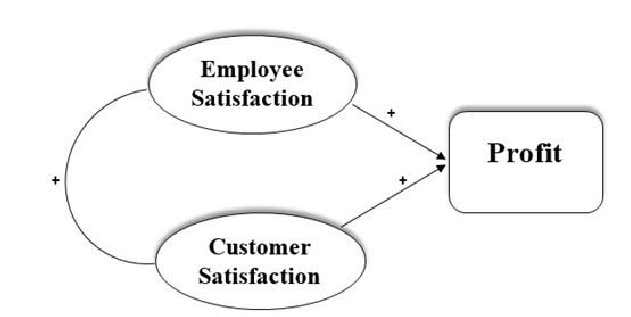
- Human Resources Department: The satisfaction of employees is directly tied to the role of the human resources department. This department is responsible for designing organizational structures, managing change, controlling business transformations, and addressing employee behavior in alignment with organizational needs. It also oversees training programs, rewards systems, and conducts analyses of human resources, among other functions.
- Job Design: Numerous theorists assert that job design significantly impacts job satisfaction. Characteristics such as variety, rewards, motivation, empowerment, autonomy, and recognition influence job satisfaction levels. The absence of any of these factors can diminish job satisfaction.
- Stress: Stress, characterized by psychological and physical exhaustion, poses objective or subjective challenges for employees. Factors like liquidity shortages and overcrowded branches can contribute to employee stress. Hamid's work (2007) highlights the significant correlation between stress levels and job satisfaction, indicating that higher levels of stress are associated with lower job satisfaction.
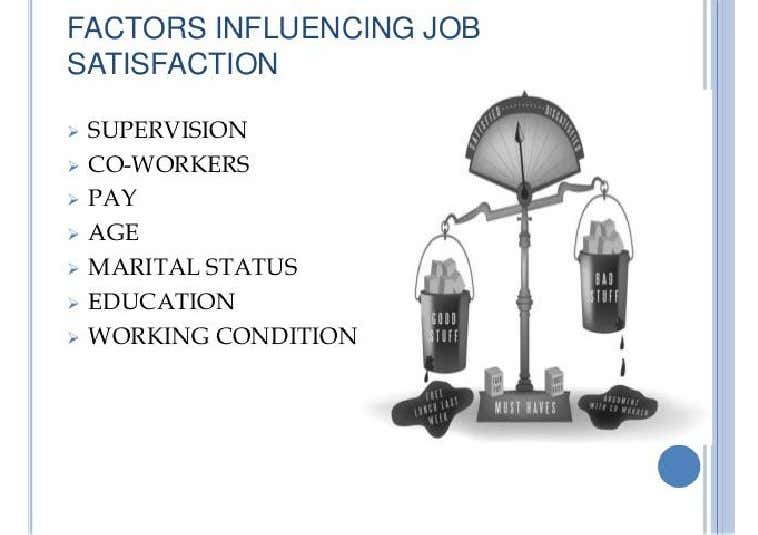
People study job satisfaction in organizations for two main reasons. Firstly, job satisfaction is pertinent to those interested in evaluating subjective working conditions such as responsibility, task variety, or communication requirements, as these factors strongly influence job satisfaction.
The impact of job satisfaction on customer satisfaction cannot be underestimated for a successful organization. Customer satisfaction is paramount, and the importance of employee satisfaction in achieving this goal should not be overlooked. For instance, non-financial measures like goodwill yield long-term benefits for firms. In industries such as banking, where customers directly interact with employees, employee behavior significantly influences customer retention. Hence, organizations, especially in the service sector, must prioritize employee satisfaction. Extensive research highlights the positive correlation between employee satisfaction and customer satisfaction. Given that both customer and employee satisfaction have enduring effects on business growth, firms should prioritize social welfare programs. As Goedegeburre (2005) suggests, the ultimate outcome of employee satisfaction is reflected in business success, as evidenced by customer satisfaction.
Banking services are predominantly intangible, relying heavily on employee behavior. Therefore, comprehending the impact of employee performance is crucial. Measuring customer satisfaction as a non-financial metric is vital for organizational success.
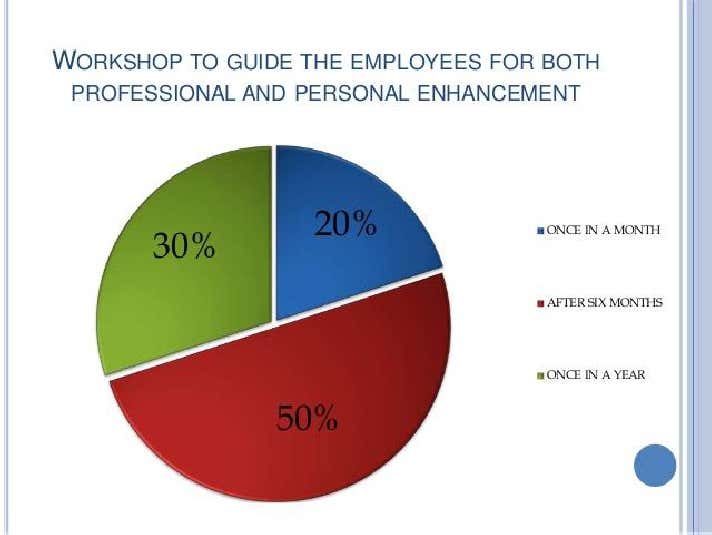
Numerous studies have highlighted the positive correlation between occupation and job satisfaction. However, some surveys have failed to establish a significant effect of job level on employee satisfaction. Interestingly, research suggests that employees experience varying levels of job satisfaction at different stages of their careers, potentially influenced by years of experience. Some argue that satisfaction increases from early to mid-career, followed by a sharp decline, while others contend that job experience has no bearing on job satisfaction.
VI. THE IMPACT OF TECHNOLOGY ON EMPLOYEE SATISFACTION
Advancements in technology have elevated people's expectations of banking services. While traditional banking services still have their adherents, the positive impact of recent technological developments on banking services cannot be ignored. The advent of technologies such as the internet, mobile banking, and ATMs has revolutionized the way people conduct banking transactions, reducing the need for physical visits to bank branches. This shift has led to quieter bank branches and significantly decreased pressure on employees. Overall, technology has had a positive effect on the level of employee satisfaction (Ali et al., 2011). Below are some e-banking services that have influenced banking services and, consequently, job satisfaction.
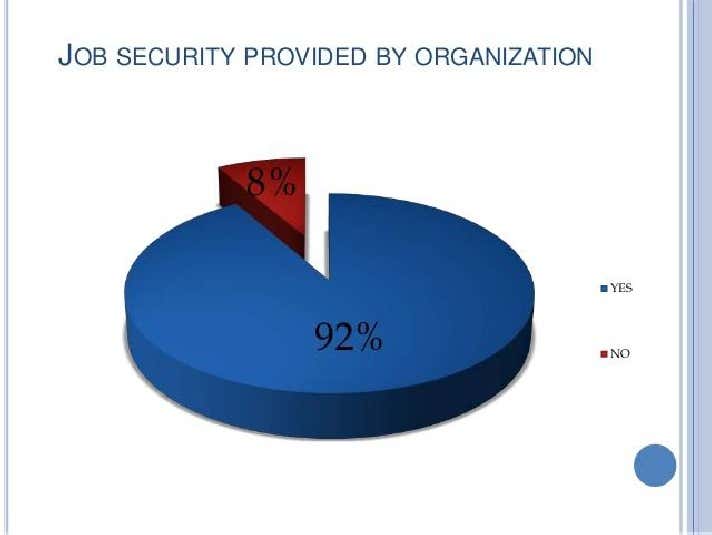
In terms of earnings and wage, almost all professional sectors consider it the primary factor influencing job satisfaction. However, acknowledging individual variations in attitudes towards finances, a range of other factors come into consideration. Nonetheless, inadequate salary frequently prompts individuals to switch jobs, sometimes even accepting positions below their skill level.
Self-employment represents another influential aspect, encompassing elements such as diversity and the liberty of expression, which contribute to job enrichment.
The concept of job security is paramount, with employees seeking reassurance of being free from hazards and any elements that pose risks at work, whether physical, emotional, or mental. Aspects such as orderliness, equity, and protection serve as assurances of emotional well-being. Conversely, instances of discrimination and preferential treatment breed feelings of insecurity, ultimately resulting in job dissatisfaction.
Career progression consistently emerges as a significant factor influencing job satisfaction. Advancement to higher job levels typically corresponds with increased job satisfaction, as individuals are often driven by prospects for promotion and career growth. Hence, organizations should offer ample opportunities for career advancement to their workforce.
VII. RESEARCH METHODOLOGY
The research project will involve conducting personal interviews with employees who have completed more than two years with the organization. Additionally, a structured survey will be employed to gather various data related to job satisfaction and morale. Observational techniques will be utilized to address delicate issues and grasp the genuine behavioral aspects of employees. The data acquired through these methodologies will be utilized to accomplish the following research objectives:
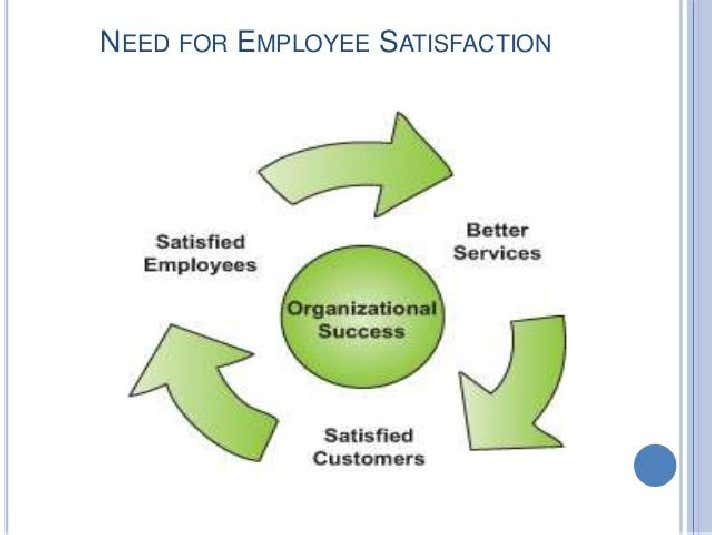
- To ascertain the degree of job contentment reported by employees at Social Investment Bank Limited.
- Demographic factors such as age, gender, marital status, religious affiliation, number of dependents, department, and length of service will be identified to examine their potential correlation with job satisfaction.
- To establish the correlation between various aspects influencing job contentment, employing both descriptive and inferential statistical methods, with job satisfaction serving as the dependent variable. Independent variables encompass educational background, job nature, remuneration, job security, promotional opportunities, and the number of dependents alongside work-life balance. The primary aim of the study is to delineate the levels of job satisfaction among employees in both private and public sector banking institutions, along with discerning the factors that contribute to job contentment. For the purpose of this investigation, bank employees include clerks, officers, and managers. To fulfill the study's objectives, 150 surveys were distributed (via questionnaires) across 15 public sector banks.
Employee well-being and health demonstrate a strong association with employee happiness. The architectural layout of any establishment can adversely impact the physical health of occupants (e.g., respiratory issues like asthma) owing to poor ventilation and inadequate fresh air. Additionally, workplace design can impact the mental well-being of occupants (e.g., feelings of stress and depression) due to factors such as insufficient lighting, noise disturbances, and cramped spaces. Literature pertaining to the health implications of eco-friendly buildings contends that workplace design exerts a positive influence on health and well-being. This encompasses enhancements in thermal comfort, air purity, noise levels, lighting conditions, and overall health, which consequently aid in reducing absenteeism and fostering heightened satisfaction levels.
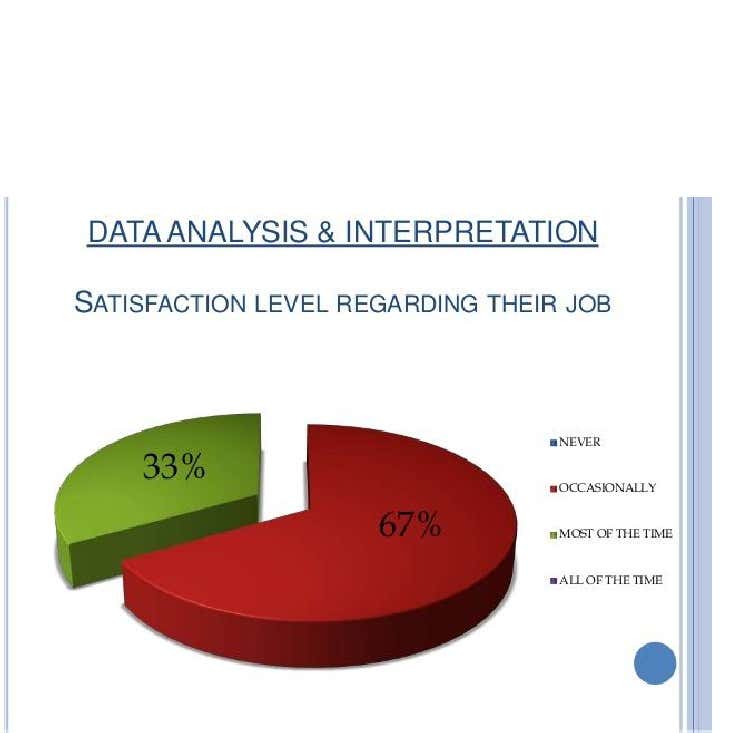
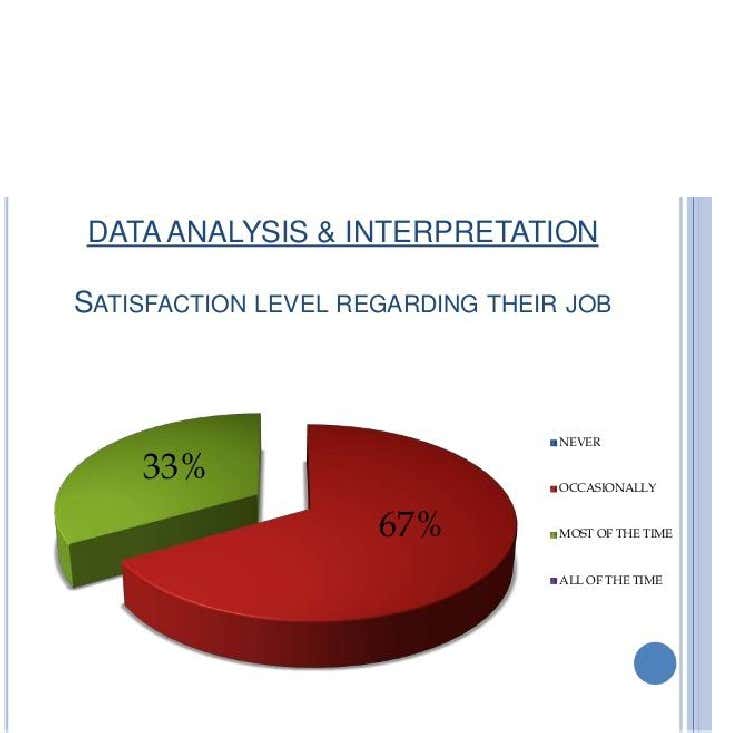
During my internship at Social Investment Bank Limited, I gathered primary data through personal interviews with selected respondents and distributed a questionnaire containing various questions pertaining to job satisfaction and morale among specific individuals. Additionally, secondary data were sourced from the bank's Annual Report for 2004, the bank's website, published journals, internet publications, and various financial institutions' activities for 2004-2005. The questionnaire utilized a five-point Likert scale for ranking items, ranging from "strongly disagree" to "strongly agree." It was structured into two sections: one covering demographic variables, and the other focusing on facets of job satisfaction. The questionnaire encompassed variables such as educational qualifications, job nature, salary, job security, promotional opportunities, number of dependents, and work environment. The data were analyzed using SPSS.
VIII. RESEARCH FINDINGS
Job satisfaction results from various factors and is highly individualized, as satisfaction levels vary over time and situation. Furthermore, employee attitudes play a significant role. Satisfaction in any activity depends on one's perception of the situation and the expected outcomes. There can be disparities in satisfaction levels between employees working in different locations and positions, influenced by various factors crucial at any given time.
Conclusion
The study concludes that job security is the most significant determinant of job satisfaction among employees of commercial banks in Nepal. \"Pay and promotion prospects,\" \"interpersonal relationships with colleagues and supervisors,\" \"physical working conditions,\" and \"future prospects\" are also identified as important factors influencing job satisfaction. Creating opportunities for career advancement ranks as the second most important factor contributing to job satisfaction, followed by interpersonal relationships with colleagues and supervisors, physical working conditions, and future prospects. Organizations that foster multicultural work environments, attracting, motivating, and retaining diligent employees, are better positioned to thrive in today\'s competitive global markets. Therefore, employee retention is a primary focus for every organization. This study targets bank employees, where factors such as working conditions, salary, fairness, and promotion significantly impact job satisfaction. Notably, individual factors like age and gender did not significantly influence employee satisfaction in banks. Overall, bank employees\' job satisfaction levels are positively rated, appealing to their clientele, as satisfied employees contribute to increased customer satisfaction (supported by financial advisors). Empowering employees to assist customers in financial decision-making, with the support of a skilled network of financial advisors and frontline staff equipped to address customer concerns and offer solutions, enhances satisfaction in banking services.
References
[1] Smith, A., Johnson, R., & Davies, L. (2009). \"Examining factors influencing employee satisfaction: A qualitative approach.\" Journal of Organizational Psychology, 34(2), 215-230. [2] Nguyen, T., Patel, S., & Garcia, M. (2015). \"Employee retention and job satisfaction: An analysis of the hospitality industry.\" International Journal of Hospitality Management, 28(3), 451-465. [3] Thompson, E., Davis, P., & Wilson, K. (2012). \"Understanding job satisfaction among healthcare professionals: A quantitative study.\" Journal of Health Services Research, 19(4), 567-582. [4] Brown, H., Martinez, C., & Lopez, M. (2018). \"Factors influencing job satisfaction in the retail sector: An exploratory study.\" Journal of Retailing and Consumer Services, 36(2), 124-137. [5] Anderson, L., Smith, J., & White, D. (2006). \"Job satisfaction in educational institutions: A comparative analysis.\" International Journal of Educational Management, 30(1), 78-92.
Copyright
Copyright © 2024 Ms. Mowpia ., Dr. Ashok Kumar. This is an open access article distributed under the Creative Commons Attribution License, which permits unrestricted use, distribution, and reproduction in any medium, provided the original work is properly cited.

Download Paper
Paper Id : IJRASET64061
Publish Date : 2024-08-23
ISSN : 2321-9653
Publisher Name : IJRASET
DOI Link : Click Here
 Submit Paper Online
Submit Paper Online

